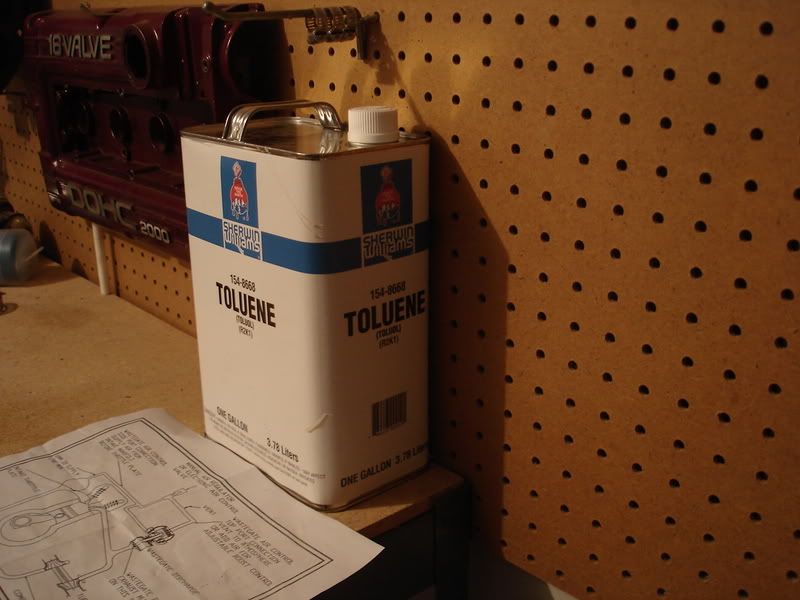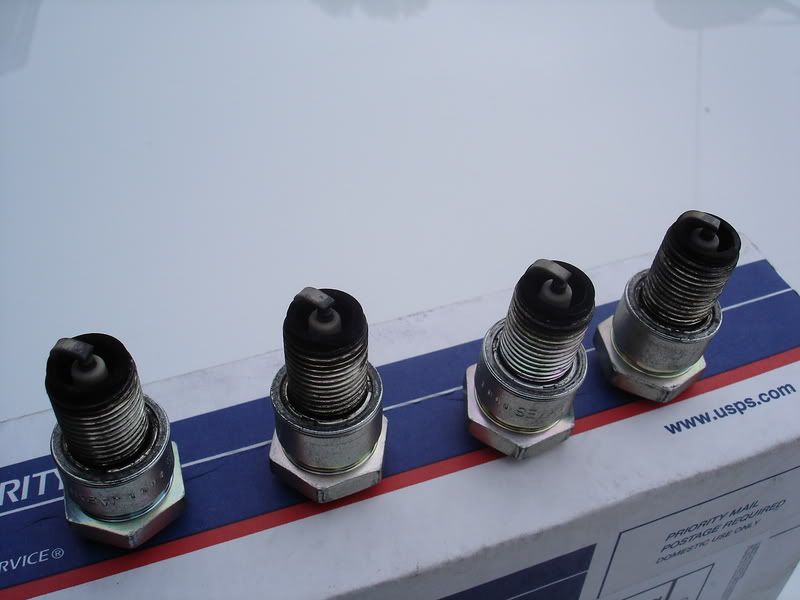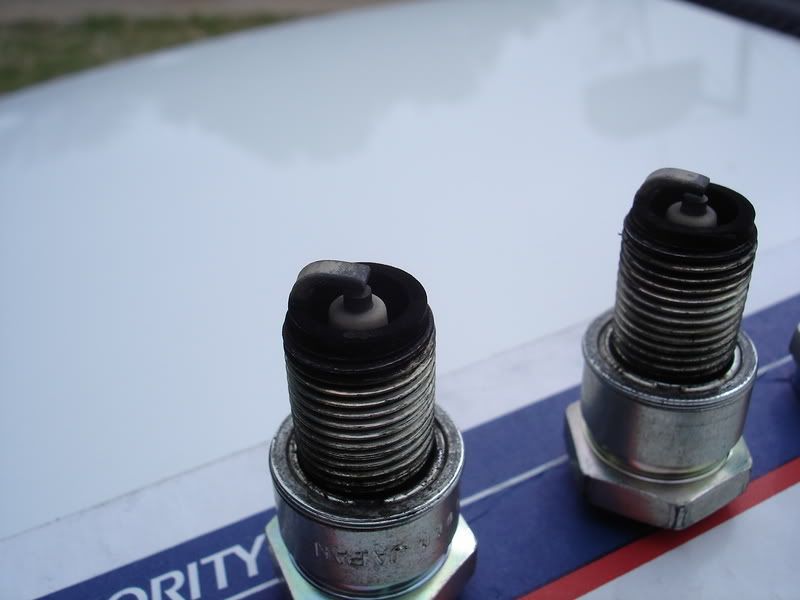You are using an out of date browser. It may not display this or other websites correctly.
You should upgrade or use an alternative browser.
You should upgrade or use an alternative browser.
Octane Booster Fuel Additive
- Thread starter KP
- Start date
-
104+ is the only one in my opinion.
DusterBoy15
THE WISE(guy) MEMBER
i got ya here i found this info =)
I used a plastic funnel to pour the xylene from its metal can into a 1 gallon plastic "gas can" -- then I used the gas can to put the stuff in the tank using the normal procedure. The xylene wasn't in the funnel or the plastic gas can long enough to cause any trouble, only a minute or two. I have heard that xylene can damage plastic, but over a period of days or weeks, not minutes.
I did spill some xylene on the ground, and a much smaller amount on the car near the gas cap. The xylene on the ground will evaporate within a day or two, and since the temperature outdoors was well below the flashpoint of xylene, it wasn't at any real risk of catching fire. But I did dump a couple of quarts of water on it to cause it to disperse a little -- it's not soluble in water, but I figured that a larger "oil slick" of xylene in the driveway was better than a small (3-4 inch) "puddle" of concentrated flammable liquid.
The spill onto the car, I also flushed with water, and then wiped repeatedly with non-abrasive paper towels until it was dry to the touch. I didn't see any paint damage. I didn't think of it at the time, but I bet that spraying some WD-40 would probably dissolve the xylene and it would clean right off no problem.
Don't mess with xylene in your garage -- do it outdoors where you don't have ventilation issues.
I wouldn't exceed a 1:3 ratio of toluene/xylene to gasoline, even though some will go as high as a 1:2 ratio. The reason is that toluene/xylene doesn't have any lubricants, detergents, or any of the other beneficial gasoline additives.
http://forums.evolutionm.net/showthread.php?s=&threadid=28471&highlight=toluene
Q: How much toluene should I use per tank of gas?
A: Octane ratings can be very easily calculated by simple averaging. For example, the tank of an Audi A4 1.8TQ is 15.6 gallons. Filling it with 14.6 gallons of 92 octane and 1 gallon of toluene (114 octane) will yield a fuel mix of:
(14.6 * 92) + (1 * 114) / 15.6 = 93.4
The Audi A4 1.8T is a good example of a car that has very high octane needs if it has been modified to produce more turbo boost. The base compression ratio of this car is a very high 9.5:1 and when an additional 1 bar (14.7 psi) of turbo boost is applied on top of it, the resulting effective compression ratio is way beyond what 92 or 93 octane fuel can ever hope to cope with. Most modified 1.8Ts running without octane enhancement are running with severely retarded ignition timing and boost.
I used a plastic funnel to pour the xylene from its metal can into a 1 gallon plastic "gas can" -- then I used the gas can to put the stuff in the tank using the normal procedure. The xylene wasn't in the funnel or the plastic gas can long enough to cause any trouble, only a minute or two. I have heard that xylene can damage plastic, but over a period of days or weeks, not minutes.
I did spill some xylene on the ground, and a much smaller amount on the car near the gas cap. The xylene on the ground will evaporate within a day or two, and since the temperature outdoors was well below the flashpoint of xylene, it wasn't at any real risk of catching fire. But I did dump a couple of quarts of water on it to cause it to disperse a little -- it's not soluble in water, but I figured that a larger "oil slick" of xylene in the driveway was better than a small (3-4 inch) "puddle" of concentrated flammable liquid.
The spill onto the car, I also flushed with water, and then wiped repeatedly with non-abrasive paper towels until it was dry to the touch. I didn't see any paint damage. I didn't think of it at the time, but I bet that spraying some WD-40 would probably dissolve the xylene and it would clean right off no problem.
Don't mess with xylene in your garage -- do it outdoors where you don't have ventilation issues.
I wouldn't exceed a 1:3 ratio of toluene/xylene to gasoline, even though some will go as high as a 1:2 ratio. The reason is that toluene/xylene doesn't have any lubricants, detergents, or any of the other beneficial gasoline additives.
http://forums.evolutionm.net/showthread.php?s=&threadid=28471&highlight=toluene
Q: How much toluene should I use per tank of gas?
A: Octane ratings can be very easily calculated by simple averaging. For example, the tank of an Audi A4 1.8TQ is 15.6 gallons. Filling it with 14.6 gallons of 92 octane and 1 gallon of toluene (114 octane) will yield a fuel mix of:
(14.6 * 92) + (1 * 114) / 15.6 = 93.4
The Audi A4 1.8T is a good example of a car that has very high octane needs if it has been modified to produce more turbo boost. The base compression ratio of this car is a very high 9.5:1 and when an additional 1 bar (14.7 psi) of turbo boost is applied on top of it, the resulting effective compression ratio is way beyond what 92 or 93 octane fuel can ever hope to cope with. Most modified 1.8Ts running without octane enhancement are running with severely retarded ignition timing and boost.
OUTLAW
Master of All Mopars
I use toululene myself in a ratio of 5 gal of 91 octane with 4 gal toululene which gives me a 101.2 for the street and 5 gal of 103 cam2 with 5 gal toululene which gives me 108.5 for the strip
DusterBoy15
THE WISE(guy) MEMBER
yup...it works just cost a little
roosduster
Colorado Mopar
Does anyone know of auto parts store bought octane boosters that work?
Dart-swinger
Banned
- Joined
- May 26, 2007
- Messages
- 309
- Reaction score
- 2
I have used 104+ since 1980 and it works as well to me as any racing or avaition gas I have used.I run one of the black bottles the stronger version of the two to 10 gallons of premium unleaded..When I started using it in 1980 you could still buy sunoco 260 leaded premium at the pump,and the 104+ in the small metal can at the time worked just as well when added to a tank of regular leaded gas.
Tolulene/Xylene are great if the ambient temps are above 65* degrees outside....plus you get a discount if you buy a 5 gallon jug over the 1 gallon can.
I prefer tolulene and have mixed it as described above at 2:1 gasoline/tolulene. or 10 gallons to 5.
30 psi boosted 4 banger no likey 91 octane :snakeman:
The benefit of tolulene/xylene is Walmart is open 24/7.
Otherwise, I would recommend using VP 110 or C116 Fuel from a reputable dealer.
I prefer tolulene and have mixed it as described above at 2:1 gasoline/tolulene. or 10 gallons to 5.
30 psi boosted 4 banger no likey 91 octane :snakeman:
The benefit of tolulene/xylene is Walmart is open 24/7.
Otherwise, I would recommend using VP 110 or C116 Fuel from a reputable dealer.
1968FormulaS340
Well-Known Member
IMHO its all junk. Just go get some race gas.
340duster
Well-Known Member
Likely the 104+ just contains a mix of toulene or xylene and other additves. But the real octane boost comes from the toulene/xylene. So you are paying alot for a bottle.
I have used up to 30% toulene (70% premium unleaded) with good results on a circle track engine running 11.8:1 comp ratio (flat top magnum 360 - 36deg timing). This is also at 2500' above seaevel: closer to sea level would require a slightly higher octane level. The rules stated "no race gas" so I followed the rules. If the rules would have said "no paint thinner" I would have been in trouble. Also the cost was about 1/2 of race fuel.
If you are using this on a street car to eliminate some pinging I would try blending in about 5% toulene and see if it fixes the problem and then go higher or lower as necessary. I would not waste my money on 104+ because you buy alot of toulene for the price of the 104+. (and the 104+ is a bit of false advertising, because to actually obtain 104+ octane you would need a whole lot of it). You can buy toulene by the 5 gal pail (I think I paid $80 for the pail).
As was mentioned the best (and most expensive) alternative is race gas.
I have used up to 30% toulene (70% premium unleaded) with good results on a circle track engine running 11.8:1 comp ratio (flat top magnum 360 - 36deg timing). This is also at 2500' above seaevel: closer to sea level would require a slightly higher octane level. The rules stated "no race gas" so I followed the rules. If the rules would have said "no paint thinner" I would have been in trouble. Also the cost was about 1/2 of race fuel.
If you are using this on a street car to eliminate some pinging I would try blending in about 5% toulene and see if it fixes the problem and then go higher or lower as necessary. I would not waste my money on 104+ because you buy alot of toulene for the price of the 104+. (and the 104+ is a bit of false advertising, because to actually obtain 104+ octane you would need a whole lot of it). You can buy toulene by the 5 gal pail (I think I paid $80 for the pail).
As was mentioned the best (and most expensive) alternative is race gas.
340duster
Well-Known Member
Industrial paint supplier or Hardware stores. It is used as a cleaner and paint thinner. Grainger might have it too
ramcharger
Dismember
Here is some very good information regarding octane boosters. 104+ raised the octane a tenth of a point. NOS octane booster fared better but it used an additive called MMT which is not sutable for long term use as it leaves metalic deposits in the combustion chambers and piston tops.
There is also some info in regards to blending your own on page 2. I know it's a 'vette site but the information is from one of Rockett Brand Fuel's chemical engineers.
http://www.idavette.net/hib/fuel/index.htm
There is also some info in regards to blending your own on page 2. I know it's a 'vette site but the information is from one of Rockett Brand Fuel's chemical engineers.
http://www.idavette.net/hib/fuel/index.htm
I use Champion Booster. It raises the fuel 15 points, 1.5 octane. You can get it at walmart. That is where i get mine. It mixes with like 20 gallons but i put it in my 14 gallon tank with 94 octane Sunoco.
JackDW
New to group old in years
Just as a reminder, if you are using an old engine w/o the hardened seats in the heads, you also need to add the lead replacement. I got a number of older stock engines and always use the lead replacements.
104+ is the only one in my opinion.
I couldn't disagree more, it is worthless
71DusterStruck
Well-Known Member
What? 91 octanes? 94 octanes? That is probably why stock American cars perform better in Europe... the lowest I can find around here is 96 octanes, I usually choose 98 octanes or 100... depending how much money I have in my pocket LOL!
ramcharger
Dismember
What? 91 octanes? 94 octanes? That is probably why stock American cars perform better in Europe... the lowest I can find around here is 96 octanes, I usually choose 98 octanes or 100... depending how much money I have in my pocket LOL!
Look closely at your fuel pump at the station and tell us if it's rated RON, MON, or R+M/2. In the states, it's R+M/2 (RON plus MON divided by 2). I'm guessing that you're seeing RON ratings which are much higher.
MadScientistMat
Well-Known Member
- Joined
- Mar 6, 2008
- Messages
- 703
- Reaction score
- 302
I've used toluene in a turbo Miata - we had been trying to set it up on a dyno display and didn't have a fan for its intercooler, so we needed an emergency octane boost to keep it from pinging. Two gallons from the local Sherwin-Williams did the job. Good thing it worked as we had to drive it several hundred miles home when the show was over.
Here is some very good information regarding octane boosters. 104+ raised the octane a tenth of a point. NOS octane booster fared better but it used an additive called MMT which is not sutable for long term use as it leaves metalic deposits in the combustion chambers and piston tops.
There is also some info in regards to blending your own on page 2. I know it's a 'vette site but the information is from one of Rockett Brand Fuel's chemical engineers.
http://www.idavette.net/hib/fuel/index.htm
What can you tell me about using/mixing Tolulene or Xylene with pumped gas?
I can tell you that pump gasonline is comprised of 75% toluene and other 0 octane filler/lubricants. One little bottle of Octane Booster is comprised of 10 fl.oz of toluene/xylene and marvel mystery oil.....and they charge nearly 10 bucks for 1 dose!!!
Xylene is not used in gasoline but has nearly the same chemical makeup and is rated at 118ish octane straight out of the can/jug.
Sherwin Williams, Wal-Mart, Lowes, Home Depot, and other paint retailers have this stuff by the 1 and 5 gallon jug.
My ole 2.0L turbocharged Eclipse AWD loved 80% toluene/20% 91 octane.....and never gave me a single problem at 30 Psi =P~. I was running 1 stage colder plugs though too...
Here is the exact stuff:

and a pic of my plugs after numerous 30 psi pulls:


Xylene is not used in gasoline but has nearly the same chemical makeup and is rated at 118ish octane straight out of the can/jug.
Sherwin Williams, Wal-Mart, Lowes, Home Depot, and other paint retailers have this stuff by the 1 and 5 gallon jug.
My ole 2.0L turbocharged Eclipse AWD loved 80% toluene/20% 91 octane.....and never gave me a single problem at 30 Psi =P~. I was running 1 stage colder plugs though too...
Here is the exact stuff:

and a pic of my plugs after numerous 30 psi pulls:


71DusterStruck
Well-Known Member
Look closely at your fuel pump at the station and tell us if it's rated RON, MON, or R+M/2. In the states, it's R+M/2 (RON plus MON divided by 2). I'm guessing that you're seeing RON ratings which are much higher.
Ok I will check that as soon as I can! Oh do you mean (R+M)/2 ?
71DusterStruck
Well-Known Member
Ramcharger you are right! From a little research I did it seems that they are selling us crap:
http://www.btinternet.com/~madmole/Reference/RONMONPON.html
Those F@cking Bast@rds!!
http://www.btinternet.com/~madmole/Reference/RONMONPON.html
Those F@cking Bast@rds!!
71DusterStruck
Well-Known Member
I checked a fuel pump today and on it was written PON which apparently is (RON+MON)/2... so it seems like I will have to take my previous comment back... but I will look in to it some more!
ramcharger
Dismember
It's in the article on page 2 that I posted the link too.What can you tell me about using/mixing Tolulene or Xylene with pumped gas?
If you have 100 octane PON readily availible, you're getting some good fuel. You are right, PON is RON+MON/2. If you're getting 100 RON, it's no better than what we get here.I checked a fuel pump today and on it was written PON which apparently is (RON+MON)/2... so it seems like I will have to take my previous comment back... but I will look in to it some more!
I got this from wikipedia: "Because of the 8 to 10 point difference noted above, this means that the octane in the United States will be about 4 to 5 points lower than the same fuel elsewhere: 87 octane fuel, the "regular" gasoline in the US and Canada, would be 91-92 in Europe. However most European pumps deliver 95 (RON) as "regular", equivalent to 90-91 US (R+M)/2, and even deliver 98 (RON) or 100 (RON)."
-
















